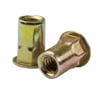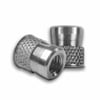
If you’re working with thin materials and need a strong, durable fastener that is removable and reusable, blind threaded inserts are the solution. Not only are they incredibly easy to install, but they’ll also enhance your application by ensuring production efficiency and durability.
What Are Blind Threaded Inserts?
A blind threaded insert—also known as a rivet nut or blind rivet—is a one-piece fastener with great flexibility and durability across applications. With internal or external threads, these counterbored tubular rivets can easily be installed as reusable threads on a workpiece in instances when the operator doesn’t have access to the “blind” side of the project.
Threaded inserts are typically made of brass, but given the growing need for sustainability, lead-free options such as aluminum or stainless steel are growing in popularity. Stainless steel provides greater corrosion resistance and strength, and aluminum threaded inserts are roughly 70 percent lighter than their brass counterparts.
Blind threaded inserts are perfect for attaching parts to tubes, castings, extrusions, or housing, and can be installed into most plastics, ceramics, and all metals of varying thicknesses. They’re also great for repairing stripped threads, creating long-lasting thread solutions.
Benefits of Threaded Inserts for Metal
With assembled workpieces, some parts need to be disassembled and reassembled, sometimes repeatedly. Flexible plastics and thin or brittle materials that require load-bearing threads benefit greatly from the use of blind threaded inserts.
Using blind threaded inserts, an operator can make quick work of an installation. With only one pair of hands and one fastener needed at each attachment point to finalize the assembly, production lines can work faster and operate more efficiently. Blind threaded inserts offer an impressive alternative to weld nuts and tapped holes, as well as tapping and self-drilling screws—all of which are time-consuming or difficult to install.
Additionally, the ribbed walls of blind threaded inserts for metal offer maximum strength to withstand the most demanding environments. They’re also designed for automation and are perfect for every stage of production. They don’t require reworking after they’ve been installed, even when the workpiece has been previously coated or painted. Some industries in which blind threaded inserts are popularly used include:
- Aerospace
- Defense
- Transportation
- Clean energy
- Medical
- Electronics
Types of Blind Threaded Inserts for Metal
Varying in size, thickness, and material, there are countless types of blind threaded inserts for applications across industries. Here are some of the most common types of threaded inserts:
- Heavy-wall thickness rivet nuts: The original iteration of these blind threaded inserts, RIVNUT®, were designed in the 1930s. These inserts are commonly used in the aerospace industry.
- Thin-wall inserts: These blind threaded inserts come in round, hexagonal, or square body configurations and offer versatility through option features such as a sealant under the head, a closed end, a knurled body, or special plating to boost weather resistance.
- Nutserts: These inserts are ideal for use with thicker materials.
- Slotted body insert: These straight and pre-bulbed fasteners are best for use in soft or brittle materials.
- Stud inserts: These threaded inserts offer a male threaded stud in the parent material for maximum integrity.
Bonus: What is a knurled body? Knurling is the process of cutting or rolling a pattern onto the outside of a fastener. With threaded inserts, the knurling pattern will directly impact torque and pull-out resistance. This means knowing whether you need straight, diagonal, helical, or some other type of knurl is critical. The most common knurled body has the hexagonal or diamond-shaped pattern, which offers incredible resistance in all directions.
AVK Threaded Inserts Offered by Bay Supply
AVK Industrial Products has been designing and manufacturing blind threaded inserts and studs since 1983. Its line of blind installed threaded fasteners is widely used in transportation and other industrial markets, and its fasteners are available in standard and metric sizes, as well as special designs.
What makes AVK fasteners superior is the manufacturing process. AVK uses high-speed, cold-forming equipment to manufacture its blind installed threaded inserts, which makes its fasteners harder and gives them greater tensile strength for lasting performance. Additionally, manufacturing of AVK threaded inserts is controlled and certified to meet ISO/TS16949 and ISO 9001 international standards.
Below are some threaded inserts for metal that AVK offers:
 A-H Threaded Hex Inserts – These semi-hexagonal inserts are designed to be used with Grade 5 or Metric Class 8.8/9.8 mating screws and fit in the corresponding hex hole so they won’t spin. When they are installed, the radius corners of the A-H Series™ insert expand to fill the hole for a secure fit. These closed-end inserts can be installed before or after finish using hydraulic tools on an assembly line.
A-H Threaded Hex Inserts – These semi-hexagonal inserts are designed to be used with Grade 5 or Metric Class 8.8/9.8 mating screws and fit in the corresponding hex hole so they won’t spin. When they are installed, the radius corners of the A-H Series™ insert expand to fill the hole for a secure fit. These closed-end inserts can be installed before or after finish using hydraulic tools on an assembly line.
 A-K Knurled Threaded Inserts – AVK’s A-K Series™ insert has a knurled body to hold it in place for a virtually flush installation, eliminating the need for countersink drilling. These inserts have a wide grip range that is 2.5 times greater than the capacity of conventional rivet nuts, and they are available in open- and closed-end configurations.
A-K Knurled Threaded Inserts – AVK’s A-K Series™ insert has a knurled body to hold it in place for a virtually flush installation, eliminating the need for countersink drilling. These inserts have a wide grip range that is 2.5 times greater than the capacity of conventional rivet nuts, and they are available in open- and closed-end configurations.
 A-L Knurled Threaded Inserts – These knurled inserts have a larger body and are ideal for use in punched or drilled holes while creating a low-profile fastening. They are available in open-end, closed-end, sealed-head, and wedge-head designs. These inserts are popular for their superior performance.
A-L Knurled Threaded Inserts – These knurled inserts have a larger body and are ideal for use in punched or drilled holes while creating a low-profile fastening. They are available in open-end, closed-end, sealed-head, and wedge-head designs. These inserts are popular for their superior performance.
 A-O Threaded Inserts – AVK’s A-O Series™ inserts have a similar low profile to the A-K series but without the knurled body. They also are narrower and can be specified for applications in which the design parameters require a smaller hole or closer tolerances. These inserts come in a range of thread sizes.
A-O Threaded Inserts – AVK’s A-O Series™ inserts have a similar low profile to the A-K series but without the knurled body. They also are narrower and can be specified for applications in which the design parameters require a smaller hole or closer tolerances. These inserts come in a range of thread sizes.
 A-R Threaded Inserts – Designed specifically for use with plastics and thin-gauge metals, the A-R Series™ offers increased resistance to pull-out. The A-R inserts also feature a PreSet™ slotted body design, so each insert folds into four segments to grip the blind side of the parent material. They are available as straight body design, with special design heads, and as stud inserts.
A-R Threaded Inserts – Designed specifically for use with plastics and thin-gauge metals, the A-R Series™ offers increased resistance to pull-out. The A-R inserts also feature a PreSet™ slotted body design, so each insert folds into four segments to grip the blind side of the parent material. They are available as straight body design, with special design heads, and as stud inserts.
 A-W Knurled Threaded Inserts – For use with softer materials that are thicker than .062/1.57 mm, these inserts are ideal for fiberglass and plywood. They deliver exceptional shear strength and resist pull-out. Brass A-W inserts are commonly used in fiberglass boat manufacturing.
A-W Knurled Threaded Inserts – For use with softer materials that are thicker than .062/1.57 mm, these inserts are ideal for fiberglass and plywood. They deliver exceptional shear strength and resist pull-out. Brass A-W inserts are commonly used in fiberglass boat manufacturing.
 R-N Rivetnut Threaded Inserts – AVK’s R-N Series® rivetnut threaded insert is a heavy-duty insert with increased wall thickness in the collapse area. Available in closed-end, keyed head, and countersunk head, these rivet nuts are useful for applications such as leg leveling.
R-N Rivetnut Threaded Inserts – AVK’s R-N Series® rivetnut threaded insert is a heavy-duty insert with increased wall thickness in the collapse area. Available in closed-end, keyed head, and countersunk head, these rivet nuts are useful for applications such as leg leveling.
AVK threaded inserts are corrosion-resistant and available in steel. Inserts in brass, aluminum, and other materials are available by special order.
When you are shopping for threaded inserts, remember that all fastener manufacturers are not the same. You need inserts that are easy to install and durable and that won’t create issues, whether you are using them on the assembly line or for shop and repair work. Over the years, we have worked with a variety of threaded insert makers, and we have found AVK Industrial Products to be one of the best in the business.
This post was updated in August 2020.


Comments